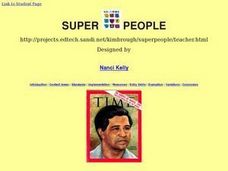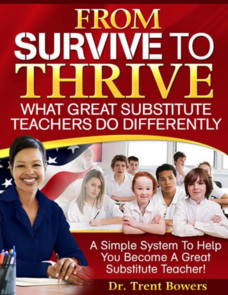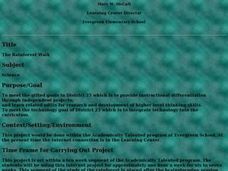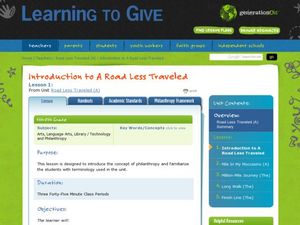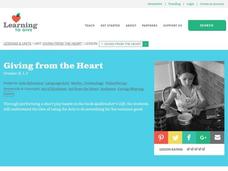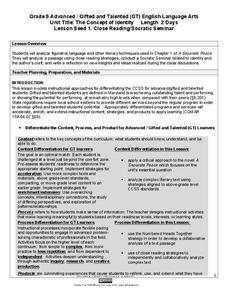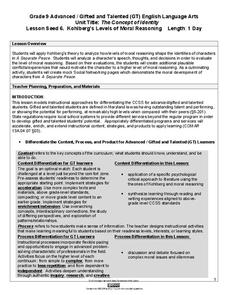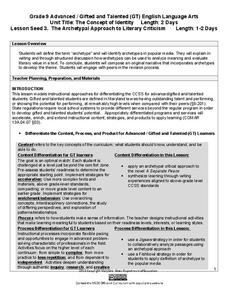Curated OER
Self-Fulfilling Prophecy in African American Students: Exploring African American Achievers
Fifth graders are introduced to ways to increase their self-esteem. As a class, they share their specific talents under three categories. In groups, they use the internet to research the lives of various African Americans making sure...
Curated OER
SUPER PEOPLE
Second graders study the talents and interests that have helped people to "make the world better." They begin by reading a story about 5 individuals who have "made a difference." This webquest extends this exploration by guiding the...
Curated OER
Doo-Wop Pop
Doo-Wop Pop, by Roni Schotter is story that focuses on music and performing arts. Language arts activities include phonics, music, writing about dreams, poetry, and writing a letter are included in this literature guide. Furthermore...
Odyssey of the Mind
Odyssey of the Mind Curriculum Activity: Shape-Shifter
Geometry is everywhere, and I mean everywhere! Those skillful mathematicians discuss shapes and then come up with a well-researched list of shapes seen in everyday applications. They put their knowledge of shapes to work as each small...
Worthington City Schools
From Survive to Thrive: What Great Substitute Teachers Do Differently
Thinking about signing up as a substitute teacher? Subbing is not for the faint of heart but with the help of the thoughtful advice in a detailed guide, you can develop the skills you need to be a great, professional substitute teacher.
Curated OER
The Rainforest Walk
Fourth graders research the characteristics and inhabitants of the rainforest. They demonstrate their ability to communicate using e-mail and create a class presentation of their research.
Curated OER
Road Less Traveled
Students define philanthropy and relate them to personal experiences. In this philanthropy lesson, students complete a journal entry and read Franklin's Christmas Gift. Students then create a philanthropy web worksheet. Students rephrase...
Curated OER
Learning to Give
Students learn what it means to give generously. In this giving lesson plan, students give examples of when they have given of themselves. Students complete a service project where they create a gift for preschoolers with whom they can...
Curated OER
Giving From the Heart: Art From the Heart
Students examine how art contributes to the common good. In this common good instructional activity, students participate in an interactive read aloud of Jeff Brumbeau, Quiltmaker's Gift. They act out the story and talk about how "Art...
Intel
Lights, Camera, Reaction!
Excite classes with a STEM project-based learning lesson covering chemical reactions. Groups study the different types through simulations and hands-on activities. They pick one type (synthesis, decomposition, single displacement, double...
Curated OER
Vocations: Archdiocese of Cincinnati
Students review virtues lived by the saints. They listen as the teacher describes the process by which a person is named a saint. Students generate a list of gifts and talents, and ways a person could use those talents in a positive,...
Curated OER
Teachers on the Horizon
Twelfth graders are given the opportunity to serve as cadet teachers for fourth and fifth-grade gifted students. In this career choices lesson, 12th graders discover how meaningful being a teacher can be.
Curated OER
Make a Giftbox Pattern
In this gift box pattern worksheet, learners cut out the ten gift box images at the bottom of the page. Then, they determine which gift box comes next in each of the 5 gift box patterns on the worksheet.
Maryland Department of Education
The Concept of Diversity in World Literature Lesson 5: The Tragic Hero
Should identifying a tragic hero be based on a universal definition or a definition based on the morals and values of a specific culture? As part of a study of Things Fall Apart, class members read Sylvia Plath's "Colossus" and then...
Maryland Department of Education
The Concept of Identity Lesson 1: Close Reading/Socratic Seminar
John Knowles' A Separate Peace provides readers with an opportunity to develop their close reading and analytical skills as they look for what Knowles feels are the factors that shape our identity.
Maryland Department of Education
The Concept of Identity Lesson 2: The Historical/Biographical Approach
"How does our environment shape our identity?" After researching biographical information about John Knowles and considering how these experiences are reflected in A Separate Peace, class members consider the strengths and weaknesses of...
Maryland Department of Education
The Concept of Identity Lesson 5: Motivation - Maslow's Hierarchy of Needs
Maslow's Hierarchy of Needs provides the lens class members use to analyze and evaluate the motivations of the characters in Sylvia Plath's "Initiation" and scenes from Mean Girls. Readers then select a character from A...
Maryland Department of Education
The Concept of Identity Lesson 6: Kohlberg's Levels of Moral Reasoning
How does our moral reasoning shape our identity? After a study of Kohlberg's Levels of Moral Reasoning, readers use Kohlberg's theories to analyze the speech, thoughts, and decisions of a character in A Separate Peace. They then...
Maryland Department of Education
The Concept of Identity Lesson 7: Logical Fallacies
What are the effects of competition in an academic environment? The competition between the main characters in A Separate Peace motivates a series of activities that asks readers to take a stance on competition, and then to develop a...
Maryland Department of Education
The Concept of Identity Lesson 8: Propaganda in Visual Media
Visual and print propaganda are featured in a lesson that asks readers of A Separate Peace to examine the techniques used in propaganda from World War I, World War II, presidential elections, and in the novel.
Maryland Department of Education
The Concept of Identity Lesson 3: The Archetypal Approach to Literary Criticism
As class members continue their study of approaches to literary criticism, readers examine the symbolism and archetypal patterns in John Knowles' A Separate Peace, and how these parallels are used to develop a theme...
Maryland Department of Education
The Concept of Identity Lesson 4: The Psychological Approach
Readers apply Sigmund Freud's theories of the unconscious mind and the psychological approach to literary criticism to analyze and evaluate the relationship between two characters in A Separate Peace.
Maryland Department of Education
The Concept of Diversity in World Literature Lesson 12: Author's Purpose - Yeats and Achebe
Is there such a thing as fate/luck? Can one fight destiny? As part of their study of Chinua Achebe's purpose in writing Things Fall Apart, class members answer these questions from Achebe's point of view and then from William...
Maryland Department of Education
The Concept of Diversity in World Literature Lesson 13: Unit Culmination - Symposium
To conclude a unit on the concept of diversity in world literature, class members conduct a symposium on "African Literature in Global Perspectives." In order to earn a spot on the panel, individuals craft an original thesis that...
Other popular searches
- Gifted and Talented
- Gifted and Talented Math
- Gifted and Talented Education
- Gifted and Talented Lessons
- Gifted and Talented Reading
- Gifted and Talented Science
- Gifted and Talented Art
- Gifted and Talented Writing
- Gifted and Talented Students
- Gifted and Talented Music
- Gifted Talented
- Gifted/talented



